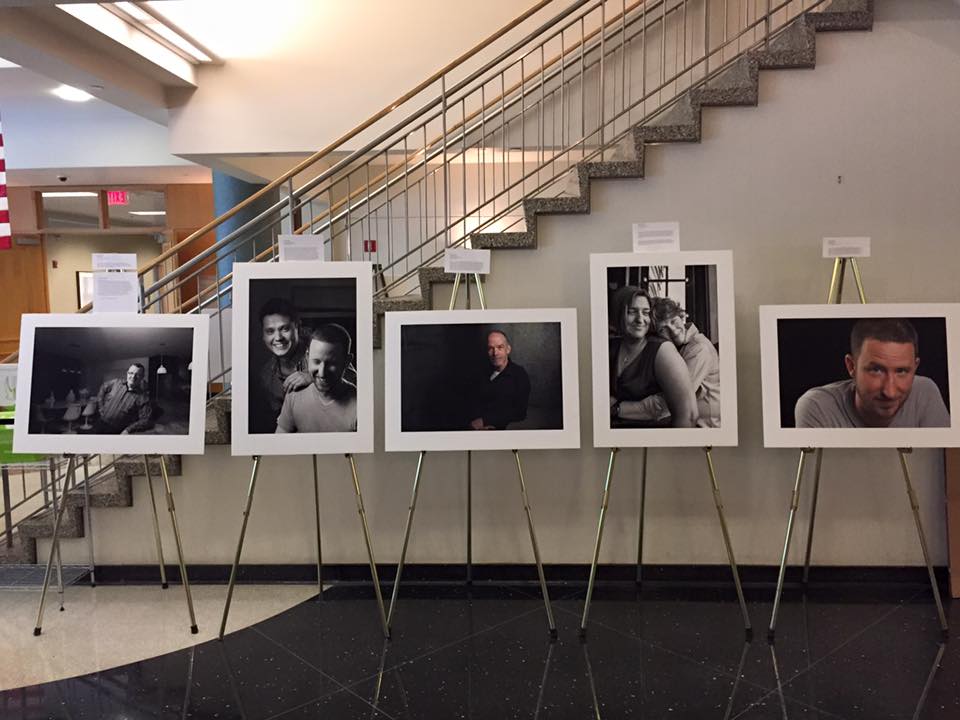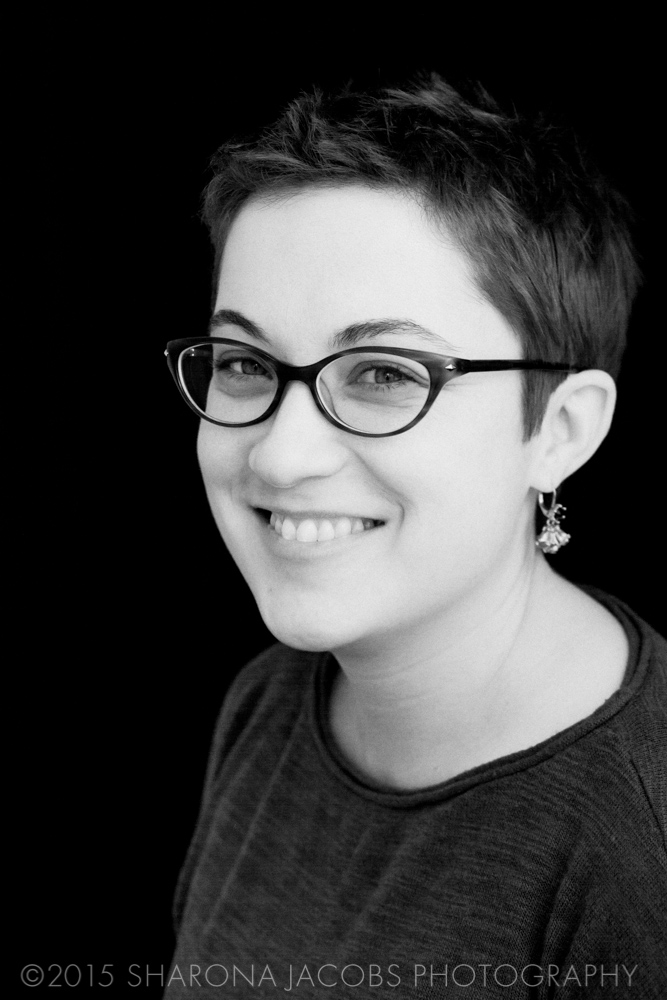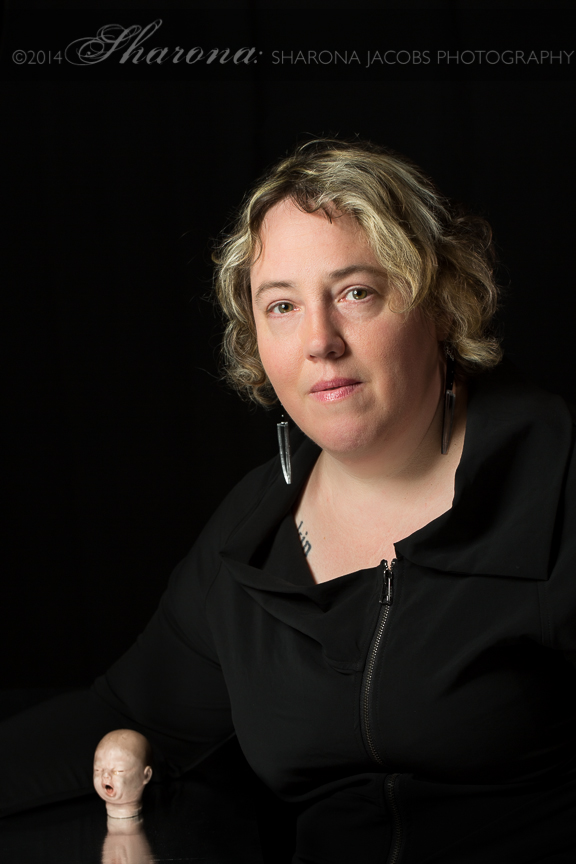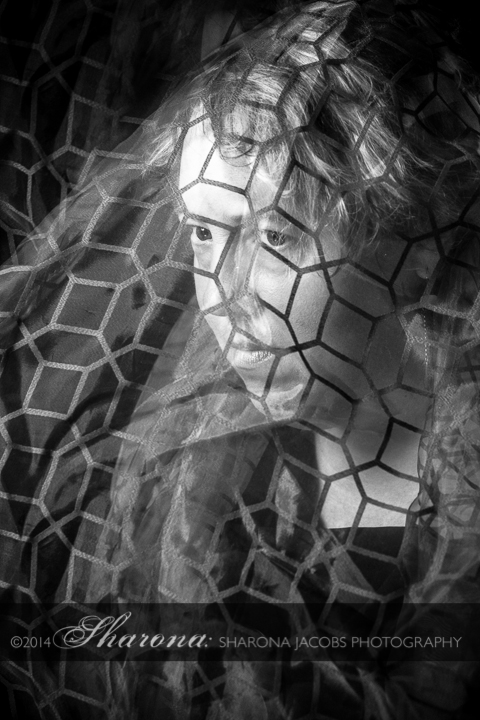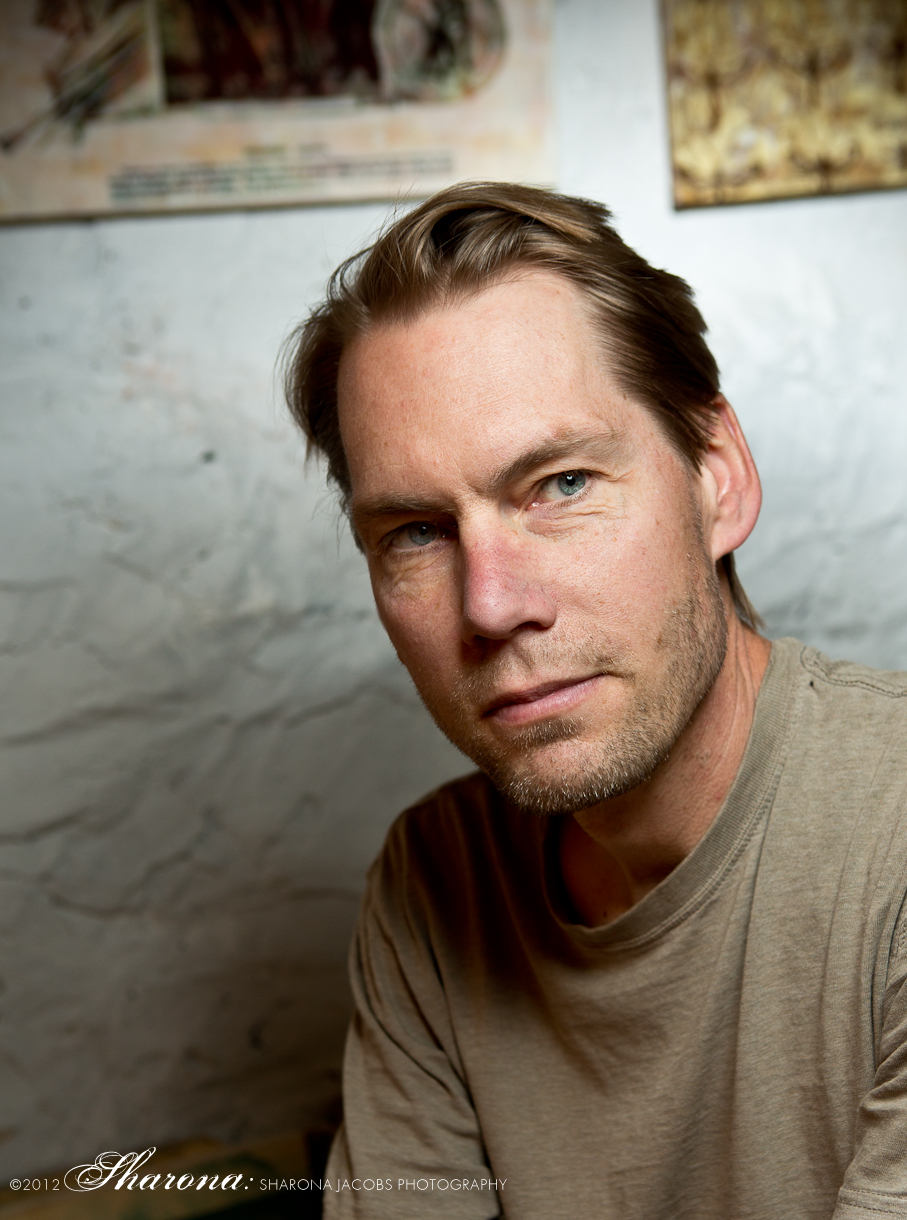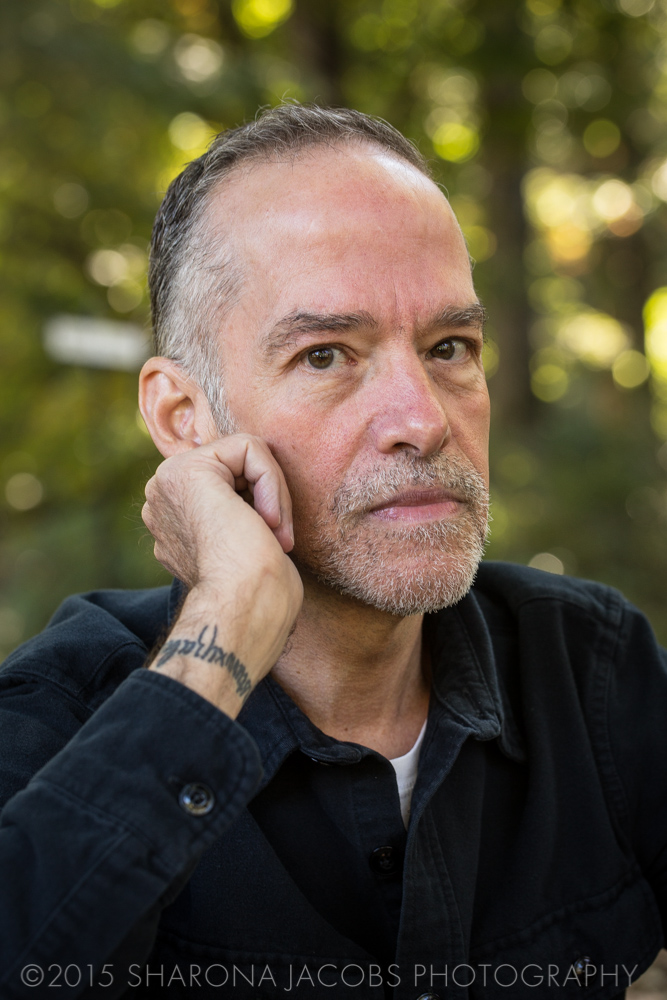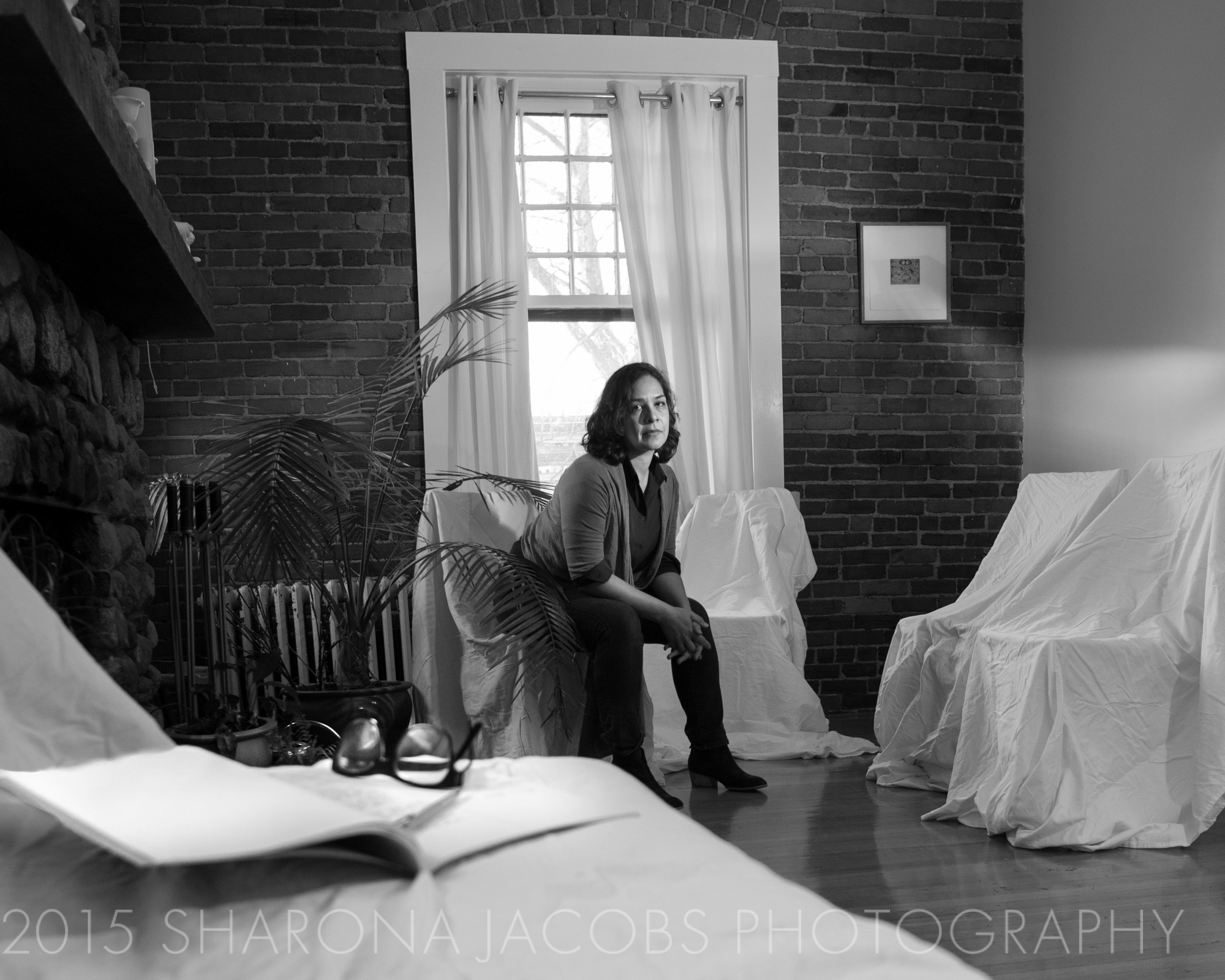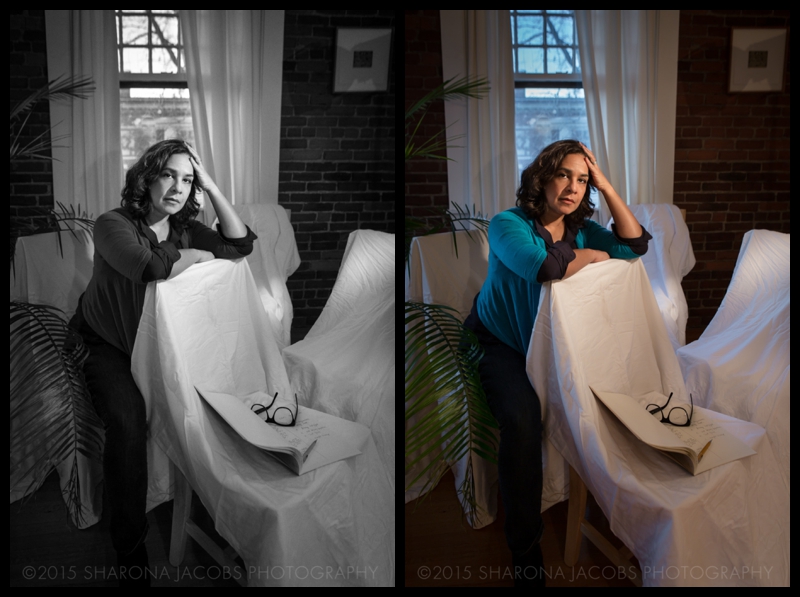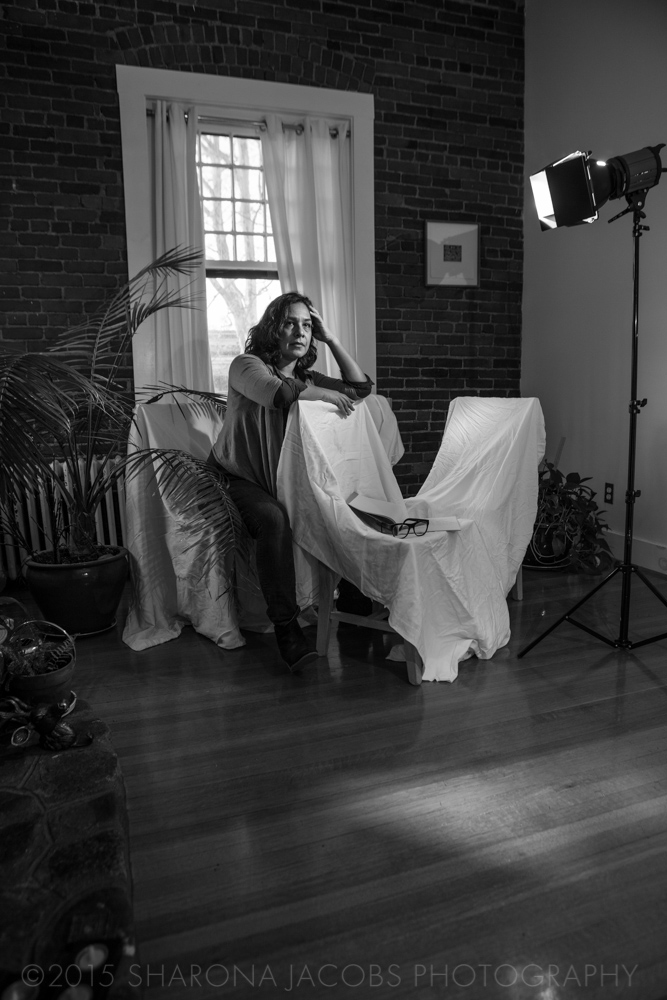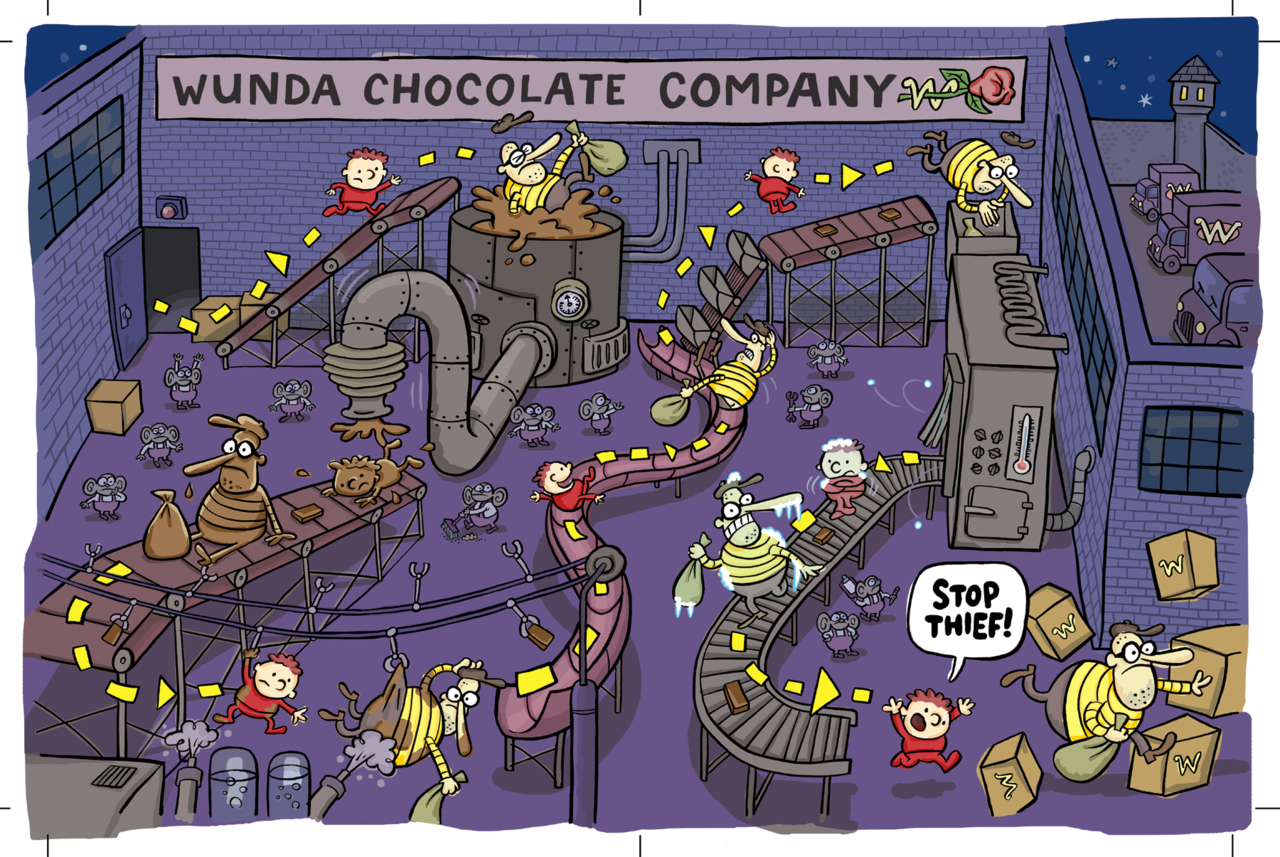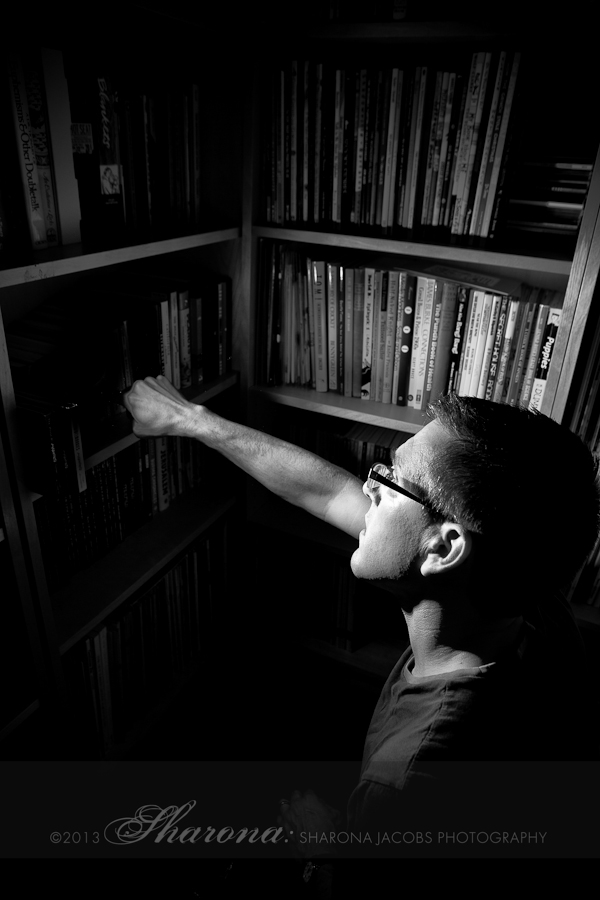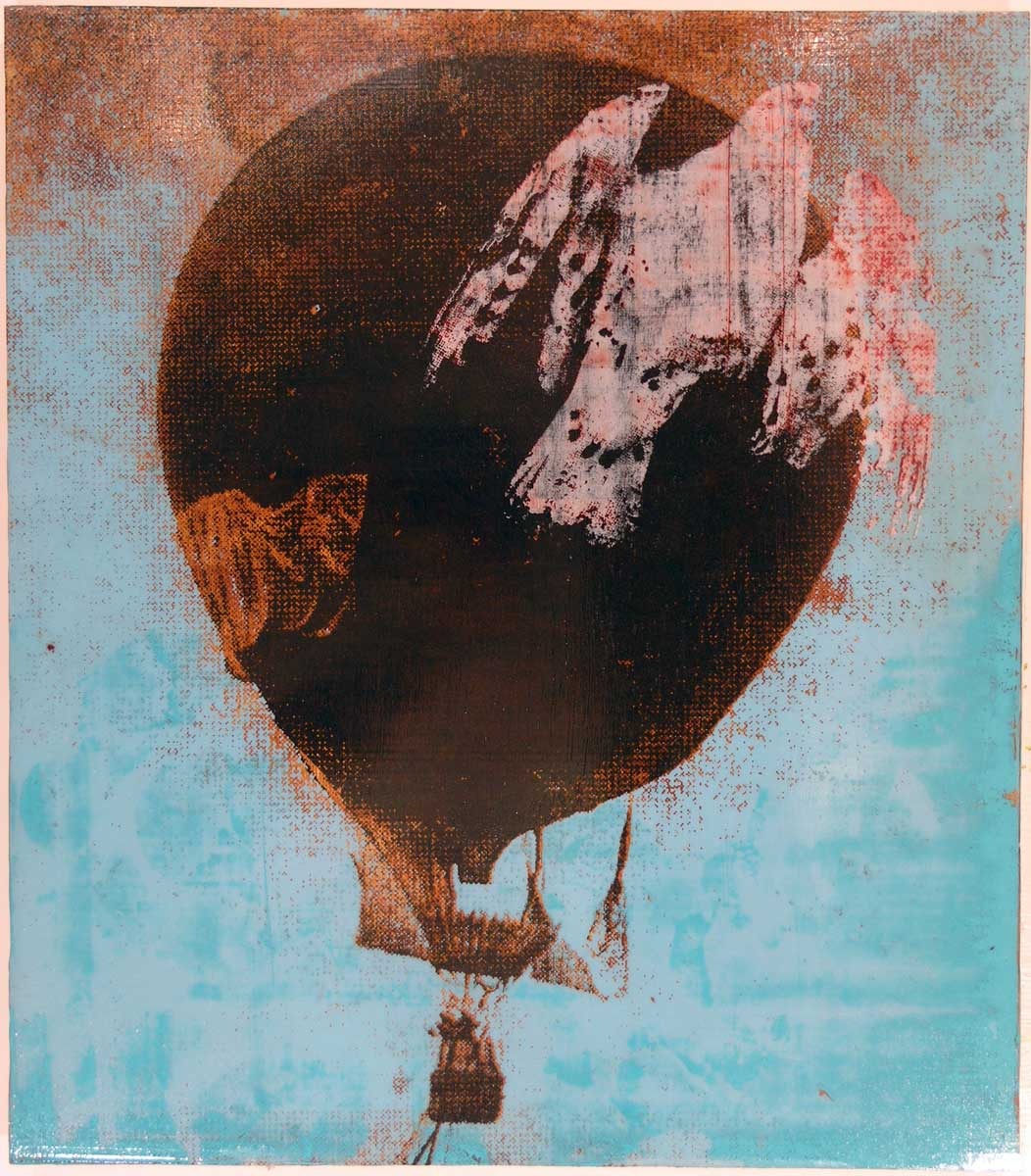Writer and jazz musician, Dominic Green, was one of the most delightful people I've had the good fortune to photograph – a mix of self-deprecating good humor, wickedly keen intelligence (he studied English Literature at St. John's College, Oxford), and a fount of wonderful anecdotes about his theater-bred family and colorful musician friends.
Read MoreBoston Artists and Authors
Shalon interview featuring artist Bradford Johnson: part of the independent creatives series
Image by Sharona Jacobs.
Last spring, I posted about the Shalon, a cross-collaborative professional creative group formed between myself, an author, an artist, and a filmmaker (we just added a mosaicist/educator as well, but more on that soon!). Inspired by the concept of 18th century French salons, we meet monthly to discuss our goals, be accountable to one another, and brainstorm ideas. The three menfolk of our group suggested the name based on the first three letters of my name.
Being an independent creative professional can challenge the most stalwart of creative souls, and this group helps keep all of us focused and productive, both creatively and from a business standpoint. I hope that this, and future interviews with fellow independent creatives will inspire and support those of us making a living with our art. In that initial post, I mentioned that I'd be focusing on the Shalon-ers individually so you can learn a little more about them and their work.
For this post, I interviewed our resident artist, Bradford Johnson. Brad has been painting now for nearly three decades and exhibited extensively in solo and group exhibitions—garnering acknowledgements and awards from such prestigious organizations as the Pollock-Krasner Foundation and Yaddo and MacDowell Artist Colonies. Throughout this time he has focused on “first-level” questions: who are we, where do we come from, why are we here, what has gone wrong, where are we going? In his work there is often an element of immanent danger and potential or actual disaster. Images of wrecked ships, airplanes, and balloons alongside ordinary human activities; indicators of aspiration and failure, calamity and hope — overlaid with time and memory. Without further ado, let's talk to Brad about his work (all images of artwork are courtesy of Bradford Johnson).
Sharona: Hi Brad, and thanks so much for speaking to us about you and your work! Could you tell us a little bit about what drives you as an artist?
Brad: I'm fascinated with the boundaries between photography and painting. I delight in criss crossing the line between both - embedding objective photographic backstories with the subjective painting process. Even during the formative training as an artist at The Rhode Island School of Design to my MFA at Hunter College, NYC, I was captivated with memory and the past in visual terms. This was central in my show at the UniLu Gallery in Cambridge MA, Spaces Between the Splendor- Painting Encounter and Conquest.
SJ: How did you first venture into the art world?
Brad: I came to art making sometime late in high school - my application to the Rhode Island School of Design a kind of afterthought amid other liberal art colleges. When I was accepted there I (naively) took this a confirmation of an artistic path. This unexpected stroke of luck or grace was the gate through which I found a vocational calling.
SJ: It's true, luck can certainly change an artist's course, both for good and the difficult! What are the greatest challenges in your work, and what helps you overcome them?
Brad: I think it's particularly hard to hold on the value of myself or my work consistently. There are plenty of metrics in the world that diminish livelong pursuit of painting (or any creative path). Painting can be isolating. There are many moments of self doubt. The only way through these periods is through community and connection. It can also be helpful to muster a determination to keep throwing any shit at the walls until something sticks.
SJ: Absolutely! Persistence is underrated as a vital commodity in an artist's survival and success. Speaking of success, whose work do you most admire or influences you?
Brad: An early guiding light for me was the quirky painter A.P Ryder and some of his obsessive gritty mysterious paintings. Later Robert Rauchenburg offered a way to work with photographic images that was liberating. I also lean pretty heavily on musicians like, Bruce Cockburn, Leonard Cohen, Jeff Buckley and Nick Cave as inspiration.
SJ: Sounds like you like to draw from multiple artistic disciplines to create your work, much like we at the Shalon like to support each others' work though we each create with different media. How is the Shalon, or meeting within other creative professional groups, helpful to you?
Brad: The Shalon has been a lifeline of artistic and personal accountability. This group of friends are a remarkably undefended fellow creatives who generously share the burdens and joys of the artistic road.
BNY Mellon | PFLAG Pride Portrait Project
Last week, I blogged about Manuel and Joe, two men I photographed for BNY Mellon and PFLAG, to showcase portraits of members of the LGBTQ community in order to raise awareness about Pride Month. Peter Tenggren, my contact at BNY Mellon who asked me to create this small group of work, sent me the below picture of the portraits, (printed by Bob Korn Imaging) now settled in the first of its four traveling stops throughout the Boston area for the month of June. I thought I'd share with you all the images, and very importantly, the words behind each person photographed, below.
The Pride Project
Artist’s Statement
I’m delighted to work with BNY Mellon and PFLAG, as a proud ally, to present this collection of five portraits of vibrant members of the LGBT community in honor of Pride Month. With each photograph, I worked to display the humanity, warmth, and intelligence of the person pictured; to show both their inner world as well as to document each person’s features, relationships, and character. Part of the process to create these images was to get to know what was important to each person, and to create a safe and warm environment so that each man and woman pictured would feel at ease to truly be themselves. My goal with each person photographed was to foster a genuine friendship and alliance enabling the viewer of the portrait to feel as though they had somehow already known the person in the photograph. As a portrait photographer, storyteller, and former psychotherapist, it is vital to me that each portrait creates a narrative and sense of recognition between the viewer and the viewed.
- Sharona Jacobs, June 4, 2015 www.sharonaphoto.com
Sharona Jacobs
The Pride Project
Amy and Lori, 2012
Archival Digital Pigment Print
20 x 30 inches
Amy:
“This portrait was taken hours before I married my best friend. It was amazing to have one of the best days of my life documented in such intimate and lovely detail. To me Pride is confidently walking down the street, holding hands with my wife while pushing our 18-month-old twins in their stroller. In the past 20 years my Prideful life has shifted from bar-fueled weekends to Saturday Gymboree outings. What hasn’t changed is me going about my out life in the most honest way possible.”
Lori:
"Pride is raising our children to know that Different doesn't mean Lesser. Differences are a good thing and we should always try to embrace what is different about ourselves and others. Our family might look a little different to some people, but it is full of love and laughter and both the family we were born with AND the family we chose."
Sharona Jacobs
The Pride Project
Mark, 2012
Archival Digital Pigment Print
20 x 30 inches
This portrait of Mark was taken the day Lori and Amy were married, and he and his partner hosted their celebration. Amy: "There’s the family you’re born with and the family you choose. Our chosen family includes two of the kindest, most generous people on the planet who opened their home to host our fabulous wedding.”
Sharona Jacobs
The Pride Project
Robin Lippincott, 2015
Archival Digital Pigment Print
20 x 27.4 inches
Robin: "I am a writer of literary fiction and nonfiction. I have two books coming out: Blue Territory: A Mediation on the Life and Work of Joan Mitchell (November 2015), and Rufus + Syd, a young adult novel co-written with Julia Watts (Spring 2016). I am also the author of the novels In the Meantime, Our Arcadia, and Mr. Dalloway, and the short story collection The 'I' Rejected. My fiction/nonfiction has appeared in over 30 journals, including "The Paris Review," "American Short Fiction," "Fence," "Memorious," "The Literary Review," "The New York Times Book Review," and others. I teach in the low-residency MFA Program at Spalding University. Simply put, pride means having the self-respect to be fully myself.”
Sharona Jacobs
The Pride Project
Manuel and Joseph, 2015
Archival Digital Pigment Print
20 x 26.5 inches
Manuel: "We are constantly making each other laugh. A common scene would include me talking about my day, but in Sofia Vergara's voice, followed by Joe bursting out laughing with his eyes shut, probably thinking to himself, "I hope this is only part of today's show, and not what I actually signed up for!" The roles reverse when Joe starts walking around the kitchen imitating a praying mantis while re-enacting a scene from Isabella Rossellini’s, "Green Porno" (which we went to see on our first Valentine). But life is not all about laughter and smiles. With our highly sensitive and introspective personalities, we often find ourseleves having to support and uplift each other, especially after reading one article too many about some form of injustice in the world. In this higly curated society driven by selfies and social media, we are proud to show all sides of our love, from laughter to tears. And as Milennials, we are thankful that we can safely show this connection outside of our private spaces (even if Joe sometimes shrugs off one too many of my PDAs)."
Sharona Jacobs
The Pride Project Joseph, 2012
Archival Digital Pigment Print
20 x 30 inches
Joe: "I have an innate fear of photographs. Perhaps it's from a youth deeply concerned with judgement and being misunderstood. Or perhaps it's because I've spent my life seeking out difference and broadening my knowledge, skills, experiences, and connections into the multi-faceted person I am today; I feared a portrait could not distill this. Yet Pride, for me, is an inversion of that fear. It is acceptance, celebration, and love for the diversity both within and outside ourselves. And it is in this light that I couldn't be more proud to show--at least an aspect of--our selves and our love.”
Shalon interview featuring author Robin Lippincott: part of the independent creatives series
A few months ago, I posted about the Shalon, a cross-collaborative professional creative group formed between myself, an author, an artist, and a filmmaker. Inspired by the concept of 18th century French salons, we decided to meet monthly to discuss our goals, be accountable to one another, and brainstorm ideas. The three menfolk of our group suggested the name based on the first three letters of my name. Being an independent creative professional can challenge the most stalwart of creative souls, and this group helps keep all of us focused and productive, both creatively and from the business standpoint. I hope that this, and future interviews with fellow independent creatives will inspire and support those of us making a living with our art. In that initial post, I mentioned that I'd be focusing on the Shalon-ers individually so you can learn a little more about them and their work. This week, I interviewed our resident writer, Robin Lippincott, the author of the novels "In the Meantime", "Our Arcadia", and "Mr. Dalloway", among many other published works.
Sharona:
Hi Robin, and thanks so much for speaking to us about you and your work. Could you tell us a little bit about you and your work?
Robin: I am a writer of literary fiction and nonfiction. I have two books coming out: Blue Territory: A Mediation on the Life and Work of Joan Mitchell (November 2015), and Rufus + Syd, a young adult novel co-written with Julia Watts (Spring 2016). I am also the author of the novels In the Meantime, Our Arcadia, and Mr. Dalloway, and the short story collection, The 'I' Rejected. My fiction/nonfiction has appeared in over 30 journals, including "The Paris Review," "American Short Fiction," "Fence," "Memorious," "The Literary Review," "The New York Times Book Review," and others. I teach in the low-residency MFA Program at Spalding University, and am also an avid film/museum/gallery goer, as well as a frequent walker in the city.
Sharona: How did you first venture into writing?
Robin: I first got into writing as a result of grief, not death but loss, as has been true for so many writers—one long, hot, long ago summer in Central Florida, where I grew up. Van Gogh's letters to his brother, collected in Dear Theo, and Anne Frank's Diary, were seminal aspects of my aesthetic and moral education that summer.
Sharona:
What are the greatest challenges in your work, and what helps you overcome them?
Robin: The greatest challenge in the work itself is simply getting it right, and in creating something that's beautiful and true. And then there are the challenges that occur at the intersection of art and commerce, at which there's most always a collision: sometimes it's only a bump or a scratch or a dent; at other times the vehicle is totaled. In both cases, you've just got to keep at it, teeth (sometimes) gritted.
Sharona: Whose work do you admire or influences you?
Robin: The list is long. I consider Virginia Woolf and D. H. Lawrence as my literary parents, with Emily Dickinson as a great aunt, and from there it's largely the great minds and/or stylists (the writer's writers), as well as a few Southern writers, whom I most admire. Here's a shortlist: Susan Sontag, Joan Didion, John Berger, William Faulkner, Flannery O'Connor, James Baldwin, Elizabeth Hardwick, James Salter, Grace Paley, James Schuyler, Toni Morrison, Renata Adler, Michael Ondaatje, W. G. Sebald, Anne Carson....
Sharona:
How is the Shalon, or meeting in other creative professional groups, helpful to you?
Robin: The Shalon is invaluable to me for several reasons. First, I believe the artistic pursuit (and the life that goes with that) is best and perhaps only really understood by other artists; in my experience, non-artists just don't/can't fully get it. And so I receive meaningful emotional support, both generally and also specifically. And I also get ideas and inspiration, and stimulation, as well as direct, inside exposure to the work of artists working in other art forms.
When a Boston blogger needs a headshot...
Katrina McCarty, who moonlights as a blogger in addition to her 9-5 policy/legislative work, contacted me because she wanted a portrait that captured her character as well as her writing conveyed her thoughts. She had seen my Boston Authors Project work, and wanted her headshot to convey her persona with a similar artistic sensibility as the Boston author portraits. No fake smiles, no staged setups, no unnecessary props. She just asked that I bring the essence of her personality to a photograph simply and elegantly, which I was delighted to do!

What I loved about working with Katrina was her wry, understated sense of humor leavened with a wicked soupçon of sarcasm. Just a tiny quirk of an eyebrow brought an entirely new meaning to a sentence and I had a terrific time working with her, laughing during the entire session. Yet Katrina also had a wonderful earthy warmth about her, and there was a lovely sense of comfort just being in her presence. I felt that bringing both these sides to her personality would be key in creating a three-dimensional portrait.
In this final image, I admit was going for a bit of Mona Lisa-style sarcasm/mystery, using Renaissance painting-like lighting techniques to convey the slightest hint of a smirk. Working with writers is one of my favorite challenges because there's so much subtext to their personalities, and bringing that richness to a photograph is one of the great joys of my job.
Kelly Link, author of "Get in Trouble", in the news
Kelly Link's new book of short stories, "Get in Trouble", came out out February 9th, 2015, and in honor of her well-recieved work, I thought I'd focus on her photo shoot from last fall. Kirkus Reviews wrote of her book, "“In stories as haunting as anything the Grimm brothers could have come up with, Link (Magic for Beginners, 2005, etc.) gooses the mundane with meaning and enchantment borrowed from myth, urban legend and genre fiction."
Kelly, a warm, gentle, and thoughtful person, was just a joy to work with. She, and her friend and fellow writer Holly Black, drove from western Massachusetts for to be photographed the same day, and we alternated between my studio and the beautiful Robbins Library in Arlington, MA. Kelly and Holly are close friends, and we all collaborated together on the shoot, both in our research and the details. Both women write in the fantasy genre, and they had developed a firm friendship after meeting at a writer's convention and discovering they lived close by.
Kelly's work, along with some of the other imagery I've taken of her, has been mentioned recently in Wired, Salon, NPR, the LA Times, and The Stranger, among many other media outlets. Congratulations, Kelly!
The Shalon: A cross-creative collaborative creation
A few months ago, four creative friends came together to create a super-powered creative group. Inspired by the concept of 18th century French salons, an artist, an author, a photographer, and a filmmaker decided to meet monthly to discuss our goals, be accountable to one another, and bounce ideas off the others as we go through the creative process, each assisted by the caffeine of their choice. The three menfolk of our group suggested the name based on the first two letters of my name, rather enjoying being clever with their words. Being a professional creative can be lonely and isolating at times, so having a group of like-minded souls creates some substance in what can sometimes feel like a vacuum. I've collaborated with each gentleman on various projects, but I'll just give you the bare bones in this post. So without further ado, let me introduce you to my team of creative superheroes. In the future, I'll be focusing on them individually so you can learn a little more about them and their work.
First is Brad(ford) Johnson, a kind-hearted and creative artist who resides in Somerville, MA, and plays with the boundaries between photography and painting. You can check out his work here.
Next we have the exceedingly talented Robin Lippincott, a writer and the author of the novels "In the Meantime", "Our Arcadia", and "Mr. Dalloway", among many other published works.
And finally, the filmmaker of our group, John Neely. John has worked in documentary filmmaking and non-fiction TV for over a decade for film, television, museums, and corporate clients. He also produced the short film about the opening of my Boston Author Project.
And there's me!
Writer's block
I recently collaborated with the lovely and insightful writer, Daphne Strassmann, in creating a shoot that represents feeling stuck creatively. Whether a writer, artist, or photographer for that matter, every creative person has faced their inner well running dry. This shoot evolved as Daphne and I were having coffee together, and she mentioned being mid-transition both literally and figuratively, and how it had affected her work; half her house had no furniture in it due to moving and construction, along with other significant changes weaving through her work and her family. All these disruptions in her external life had affected how she moved forward with her memoir.

Something about the way Daphne described her empty rooms called to me, along with what was happening in conjunction with her life, and I wanted to capitalize on that while photographing this very thoughtful person. I felt really excited as she described her empty rooms. So, as I arrived at Daphne's place in Brookline, MA, I was delighted by the raw structure of the space as well as the feeling of only slightly ornamented emptiness I found.
Only minimally draped furniture, and just a few odds and ends decorated the room, as Daphne took her place in it. Only her glasses and the notebook she used for her note taking were well-used items. I had Daphne either gaze at me our out the window as I worked and tested, noting her body language as time went by, and noticing when she didn't react to me any more, as I blended into the unheeded draped furniture surrounding Daphne, only calling quietly to look towards me occasionally when she had settled into her own thoughts.
The faceless portrait: author, illustrator, and sculptor Adam J. B. Lane
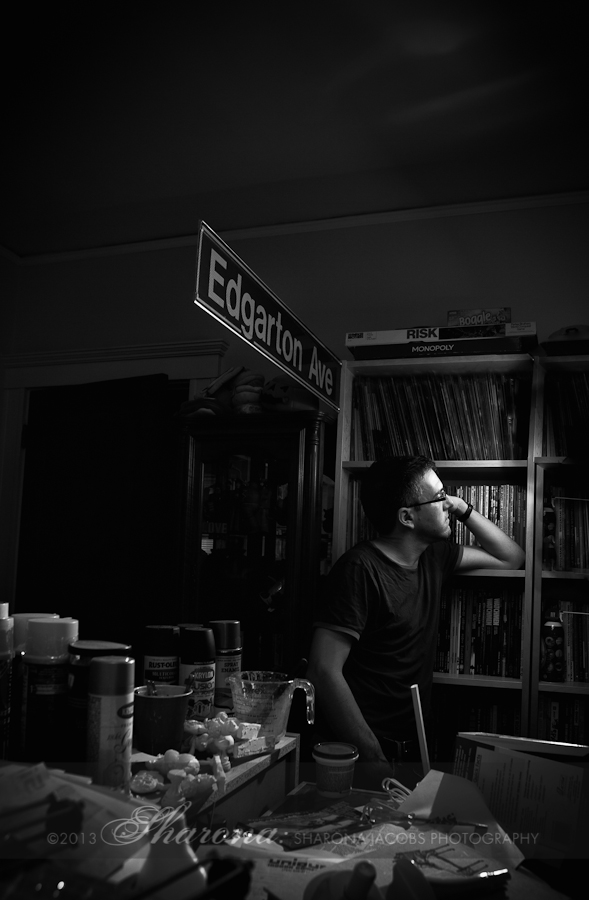 When I interview artists and authors before I photograph their portraits, the first question I ask is whether the person I'm photographing has any special requests, ideas, or preferences, far before I take out my camera.
Children's book author/illustrator/sculptor (narrowing this fellow into a category is a challenging task) Adam J. B. Lane's request was a creative stretch for this portrait photographer: he asked if I could take his photograph without the viewer really knowing what he looked like, so that he could be passed by unrecognized by someone seeing his portrait the moment before.
When I interview artists and authors before I photograph their portraits, the first question I ask is whether the person I'm photographing has any special requests, ideas, or preferences, far before I take out my camera.
Children's book author/illustrator/sculptor (narrowing this fellow into a category is a challenging task) Adam J. B. Lane's request was a creative stretch for this portrait photographer: he asked if I could take his photograph without the viewer really knowing what he looked like, so that he could be passed by unrecognized by someone seeing his portrait the moment before.
Curious, I asked why. Adam said he was influenced both by the legendary radio producer Ira Glass and also the author Daniel Handler ("Lemony Snicket") who felt that viewing the physical appearance of a formerly faceless narrator robbed a story of some abstraction and potency. Adam had always personally found the difference between the impression created by the work and the author in reality a bit of a disappointment, and preferred to be photographed in a way that left something to the imagination.
So I took the approach of letting the images reveal the author primarily through his activities and the wonderful textured environment of his home studio, rather than the entirety of his face. I lit enough of Adam to pull him away from his background, but not enough to define his features. His illustration work is dark and contrasty, and I mirrored some of that feeling through to the photographs.
Adam recently published Stop Thief, a story of a little boy who takes off after a stuffed animal snatcher. His illustrated books are aimed at children, but have a chiaroscuro palette often associated with darker themes. The Lemony Snicket influence shines though Adam's color choices.
The product of both a British and American upbringing, Adam was heavily influenced by comics throughout his childhood and maintains that his success communicating with children comes through a strong case of arrested development. As a child, he remembers not being able to conceive of adulthood and was terrified that life would end after his bar mitzvah, around the age of thirteen.
Later, Adam went on to write and illustrate for the Harvard Lampoon, and upon graduation, moved to Los Angeles to work on Disney feature films.
While at Disney, Adam started going to book stores to do research on what kids wanted in their favorite stories, and fell in love with picture books. He delved into creating stories because he wanted to do something for kids and parents to actively do together, and to be part of the magical relationship of a parent reading a story to a child.
Boston's artists and authors, featuring Bradford Johnson
I'm embarking on a new project to create portraits of some of Boston's most talented artists and authors. Each artist is interviewed and then documented in the space that they work in, or a space inspired by their work. The goal of the project is to reveal through the photographs a real sense of the artist, to tell their stories visually and through narrative, and to gain an understanding of where their work comes from.
 The first artist I'm featuring is Somerville, MA-based artist Bradford Johnson. Brad's wonderful warm intelligence, wry wit, and good humor was a joy to be around, and spending time with him in his studio was delightful. His work is based on painting the people and places first captured by distant photographers (hmm, wonder why I like this guy?). One of his projects that I find most intriguing is entitled, "Tangible Dreams of a Dying Explorer", and it is based upon the real-life experiences of an Arctic explorer who perished more than one hundred years ago, but whose photographic film was discovered 30 years after the expedition's demise.
The first artist I'm featuring is Somerville, MA-based artist Bradford Johnson. Brad's wonderful warm intelligence, wry wit, and good humor was a joy to be around, and spending time with him in his studio was delightful. His work is based on painting the people and places first captured by distant photographers (hmm, wonder why I like this guy?). One of his projects that I find most intriguing is entitled, "Tangible Dreams of a Dying Explorer", and it is based upon the real-life experiences of an Arctic explorer who perished more than one hundred years ago, but whose photographic film was discovered 30 years after the expedition's demise.
As Brad explains: "In 1897, on a barren Arctic island, photographer Nils Strindberg finally escapes the brutal cold when he slips into hypothermia. Shortly thereafter, he becomes the first member of S.A. Andree's Polar Expedition to perish. As Strindberg loses consciousness, he cannot know if his human remains or exposed film will ever be returned to civilization. His compatriots bury him in a rocky grave, and their demise soon follows his. Months earlier, in a daring attempt to explore the North Pole, Strindberg, Knut Fraenkel and Andree pilot a hydrogen balloon into the polar region under the flag of Sweden. Strindberg conscientiously documents key moments even when they crash far short of the pole and are forced to trek for months across the pack ice in an attempt to return home. The remnants of their final camp are discovered over 30 years after their deaths. Among the detritus returned to civilization are detailed diaries and 5 rolls of Strindberg's exposed film. 93 viable negatives are miraculously salvaged."
I photographed Brad in his studio, after chatting with him about how he was drawn to art, what he studied, how he defined himself as an artist, and how he combined his work with being a dad to two kids.
The moment he started to feel like an artist: Brad fell into art in high school - it was his sanctuary. Like many, high school was kind of a drag for him - he didn't really have any energy for the academics, but painting was something that drew him in. During his senior year when thinking about his future, Brad felt kind of lost, but his art teacher suggested that after graduation, he apply to RISD - the Rhode Island School of Design (one of the nation's top art schools) - and he got in.
Three words that describe Brad's work: "Narrative, material, hand-rendered."
But it wasn't easy: Sometimes its easy to doubt your own abilities. While at RISD, Brad felt like an imposter, despite his abilities, surrounded by other talented artists who were Artists with a capital A. He transferred to a small, vigorously academic liberal arts school, where he enrolled in the drama department, and found like-minded souls. But eventually, the visual arts kept calling, and he switched back to studying fine art, continuing his studies with a MFA from Hunter College in New York, where he lived for five years before moving to Boston to be with his wife.
Finally: "I'm an artist, finally, because I'm unsatisfied with any given answer."
Artist as adult: Artists are often considered solitary creatures, huddled in a garret somewhere, but artists merge into adulthood like those of us in more traditional professions, with all the responsibilities that entails. Brad has two children and a wonderful, supportive wife, Jackie. I asked Brad how the balance works for him, and how difficult it is to pursue his vocation while wrangling pre-schoolers. His response - "it's a whole lot harder, but doable", thanks to great childcare, and a wife with a more traditional employment situation. He also credits a network of fellow creative friends who bounce ideas and provide support for each others' ventures.





